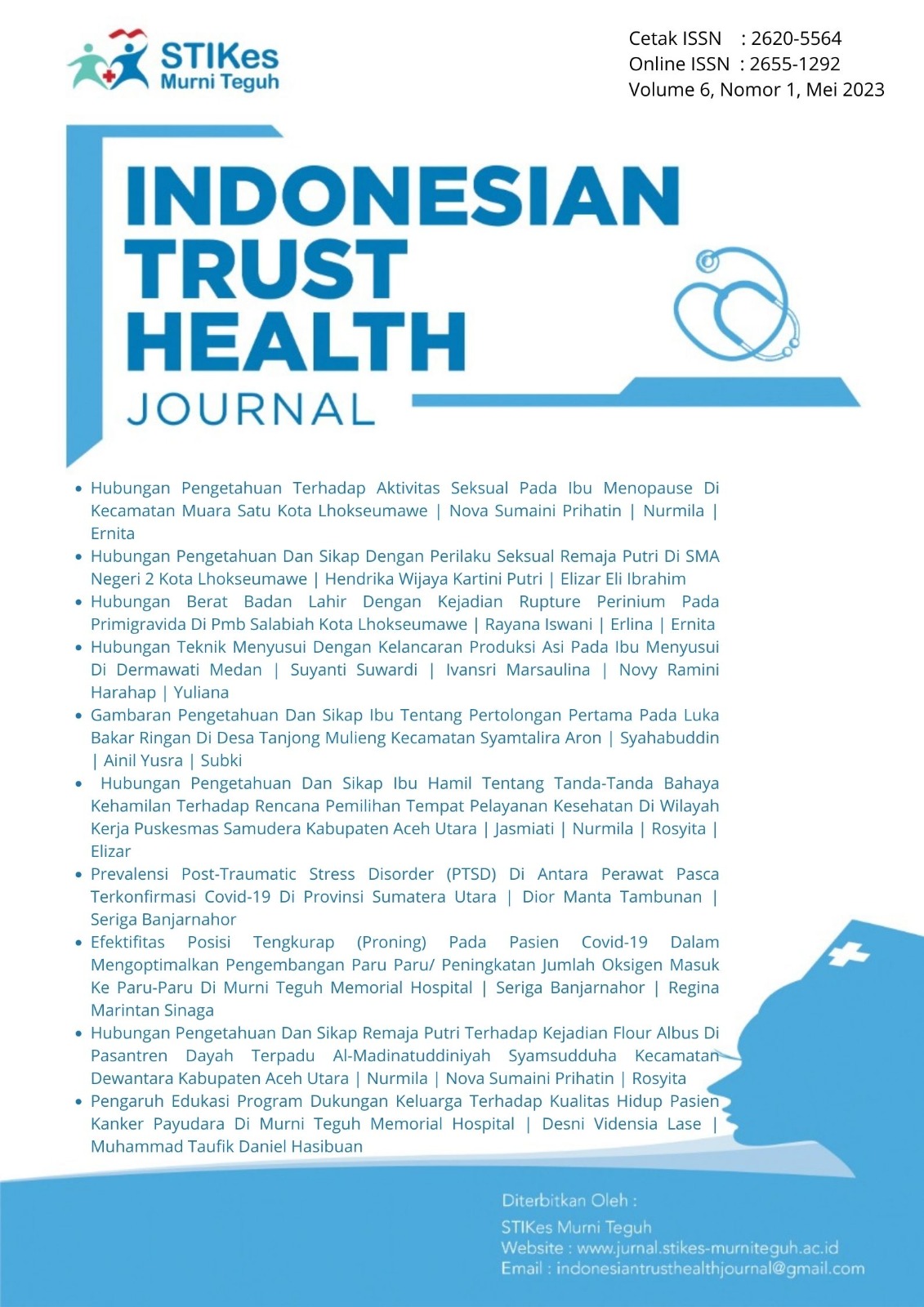EFEKTIFITAS POSISI TENGKURAP (PRONING) PADA PASIEN COVID-19 DALAM MENGOPTIMALKAN PENGEMBANGAN PARU PARU/ PENINGKATAN JUMLAH OKSIGEN MASUK KE PARU-PARU DI MURNI TEGUH MEMORIAL HOSPITAL
Abstract
Corona Virus Disease 2019 (COVID-19) is still a world health problem. COVID-19 cases are caused by a virus called Severe Acute Respiratory Syndrome Coronavirus 2 (SARS-CoV-2). WHO reported that the number of confirmed cases of COVID-19 in the world as of September 30, 2020, was 44 million cases. The total number of COVID-19 patients who died was 1,174,624 people. Patients treated at Murni Teguh Memorial Hospital have different responses to COVID-19. The most common symptoms are fever, cough, tightness, fatigue, discomfort and pain, sore throat, diarrhea, conjunctivitis (red eyes), headache, loss of sense of taste or smell, rash on the skin, or discoloration of fingers or toes, difficulty breathing or tightness caused by the buildup of secretions (mucus) in the respiratory tract eventually if this cannot be overcome the patient hypoxia even to death. In handling COVID-19 patients, especially the problem of airway clearance from secretions (mucus) by optimizing supportive care such as adjusting the prone position (proning), this position will help increase the amount of oxygen entering the patient's lungs and optimize the development of the patient's lungs. This research is a strengthening of the institutional system and to determine the effectiveness of the prone position (proning) in COVID-19 patients in optimizing the development of the patient's lungs / increasing the amount of oxygen entering the lungs of patients at Murni Teguh Memorial Hospital.This research is a type of Quasy Experiment research with the one group pretest-posttest design method The data collection method was obtained directly from respondents with interview techniques and observation before and after the intervention. The intervention carried out adjusts the position of the respondent on his stomach, the position of the arms treading on the left and right sides of the head, head rotation can be done every 2 hours to the left and right (can shrug to help the head rotate) as needed, the position of the respondent for 8-16 hours / 24 hours (unless there is an urgent or emergency condition). The collected data were analyzed by t-test analysis at a 95% confidence level. which aims to compare spO2 levels before and after the intervention. The results of this study showed a difference in the average oxygen saturation after being tested using SPSS with a t-test (p < 0.05) between respondents before and after the intervention (p = 0.002) on the application of the proning position. The mean value of SpO2 in respondents before intervention was 90.2 and the mean value of SpO2 in respondents after intervention was 97.93. The conclusion of the results of this study is that the prone position (proning) is effective in optimizing the development of the patient's lungs / increasing the amount of oxygen entering the lungs in COVID-19 patients at Murni Teguh Memorial Hospital.
Abstrak
Corona Virus Disease 2019 (COVID-19) sampai saat ini masih menjadi masalah kesehatan dunia. Kasus COVID-19 disebabkan oleh virus yang bernama Severe Acute Respiratory Syndrome Coronavirus 2 (SARS-CoV-2). WHO melaporkan bahwa kasus COVID-19 yang telah dikonfirmasi di dunia sampai dengan tanggal 30 September 2020, yakni sebanyak 44 juta kasus. Jumlah total pasien COVID-19 yang meninggal ada sebanyak 1.174.624 orang. Pasien yang dirawat di Murni Teguh Memorial Hospital memiliki respons yang berbeda terhadap COVID-19. Gejala yang paling umum demam, batuk, sesak, kelelahan, rasa tidak nyaman dan nyeri, nyeri tenggorokan, diare, konjungtivitis (mata merah), sakit kepala, hilangnya indera perasa atau penciuman, ruam pada kulit, atau perubahan warna pada jari tangan atau jari kaki, kesulitan bernapas atau sesak yang diakibatkan adaya penumpukan sekret (lendir) pada saluran pernapasan pada akhirnya jika hal ini tidak dapat diatasi pasien terjadi hipoksia bahkan sampai pada kematian. Dalam penangan pasien COVID-19 khususnya masalah bersihan jalan napas dari sekret (lendir) dengan mengoptimalkan perawatan suportif seperti mengatur posisi tengkurap (proning) posisi ini akan membantu meningkatkan jumlah oksigen yang masuk ke paru-paru pasien dan mengoptimalkan pengembangan paru-paru pasien. Penelitian ini merupakan penguatan sistem kelembagaan dan untuk mengetahui efektifitas posisi tengkurap (proning) pada pasien COVID-19 dalam mengoptimalkan pengembangan paru paru pasien/peningkatan jumlah oksigen masuk ke paru-paru pasien di Murni Teguh Memorial Hospital.Penelitian ini merupakan jenis penelitian Quasy Experiment dengan metode one group pretest-posttest design Metode pengambilan data diperoleh secara langsung dari responden dengan teknik wawancara dan observasi sebelum dan sesudah intervensi. Intervensi yang dilakukan mengatur posisi responden tengkurap posisi lengan menapak di sisi kiri dan kanan kepala dapat dilakukan rotasi kepala setiap 2 jam ke kiri dan ke kanan (dapat mengangkat bahu untuk membantu kepala rotasi) sesuai kebutuhan, posisi responden selama 8-16 jam/ 24 jam (kecuali ada kondisi mendesak atau darurat). Data yang telah dikumpulkan dianalisis dengan uji analisa t-test pada tingkat kepercayaan 95%. yang bertujuan untuk membandingkan tingkat spO2 sebelum dan sesudah intervensi.Hasil penelitian ini menunjukkan adanya perbedaan rata-rata saturasi oksigen setelah diuji menggunakan SPSS dengan uji t-test (p<0,05) antara responden sebelum dan sesudah intervensi (p=0,002) terhadap penerapan posisi proning. Nilai mean SpO2 pada responden sebelum intervensi adalah 90,2 dan nilai mean SpO2 pada responden sesudah intervensi adalah 97,93. Kesimpulan hasil penelitian ini yaitu posisi tengkurap (proning) efektif dalam mengoptimalkan pengembangan paru-paru pasien/ peningkatan jumlah oksigen masuk ke paru-paru pada pasien COVID-19 di Murni Teguh Memorial Hospital.
References
2. Keputusan Menteri Kesehatan Republik Indonesia. (2020). Pedoman pencegahan dan pengendalian corona virus disease 2019 (COVID-19)
3. WHO. (2020). Modes of transmission of virus causing COVID-19: implications for IPC precaution recommendations. Diakses dari https://www.who.int
4. Persi. (2020). Pneumonia covid-19: diagnosis & penatalaksanaan di indonesia. Jakarta: Perhimpunan Dokter Paru Indonesia
5. Chang, Le., Yan, Y., & Wang, L. (2020). Cronavirus disease 2019: coronaviruses and blood safety. Transfusion Medicine Reviews.
6. Wang, W., et al. (2020). Detection of SARS-CoV-2 in different types of clinical specimens. J. Am. Med. Assoc. https://doi.org/10.1001/jama.2020.3786
7. Chairul, H., & Agung, W. (2022). Modified prone position pada pasien long covid-19 untuk meningkatkan saturasi oksigen perifer. Jurnal Keperawatan Silampari.
8. Nasrun, P., Ayu, L., Tirta., Zulkifli, P., & Jerwati, Y. (2022). Prone position pada dewasa dan bayi terhadap saturasi oksigen di ruangan intensive. Jambura Nursing Journal.
9. P J A, I Gusti Ngurah., Wayan, E J., I made, A A., & Kadek, A, I. (2023). The effect og prone position for increasing oxygen saturation of covid-19 patients. Babali Nursing Research.
10. Caputo, et al. (2020). Early self-proning in awake, non-intubated patients in the emergency department: a single ed’s experience during the covid-19 pandemic.
11. Padrao, et al. (2020). Awake prone positioning in covid-19 hypoxemic respiratory failure : exploratory findings in a single-center retrospective cohort study.
12. Dubosh et al. (2020). Early, awake proning in emergency department patients with COVID-19. American Journal of Emergency Medicine.
13. Coppo, anna., et al. (2020). Feasibility and physiological effects of prone positioning in non-intubated patients with acute respiratory failure due to covid-19 (pron-covid): a prospective cohort study.
14. Doussot., et al. (2020). Prone positioning for severe acute respiratory distress syndrome in covid-19 patients by a dedicated team : a safe and pragmatic reallocation of medical and surgical work force in response to the outbreak.
15. Solverson, Weatherald, & Parhar. (2021). Tolerability and safety of awake prone positioning COVID-19 patients with severe hypoxemic respiratory failure.
16. Weiss et al. (2021). Prone positioning for patients intubated for severe acute respiratory distress syndrome (ARDS) secondary to COVID-19: a retrospective observational cohort study. British Journal of Anaesthesia
Copyright (c) 2023 Indonesian Trust Health Journal

This work is licensed under a Creative Commons Attribution-ShareAlike 4.0 International License.
















